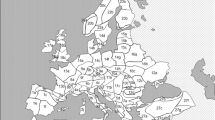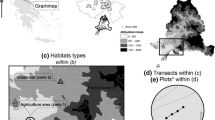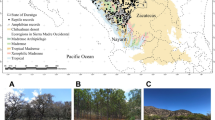Abstract
We used the carabid beetles inhabiting the Castelporziano Presidential Estate reserve (a natural reserve of some 60 ha facing the Tyrrhenian sea) to show how chorotypes (i.e. species distribution types) can be used to characterise insect communities. We compared three forms of diversity: species richness, Clarke and Warwick taxonomic diversity and chorological composition. Chorological composition was modelled using Menhinick, Margalef, Shannon, and Brillouin diversity, Simpson dominance, Pielou evenness and Buzas and Gibson evenness. Variations in carabid species richness, chorological composition (richness, diversity, dominance and evenness) and taxonomic diversity among biotopes followed different patterns thus providing complementary not redundant information. Beach, dunes, high maquis and oak forest were biotopes with low species richness, whereas wet woodlands, mixed forest, wet zones and open areas have high species richness. Low maquis had an intermediate position. This subdivision is substantially confirmed by indices of chorological composition. However, in contrast with large variations in diversity indices, evenness was substantially similar, and relatively high in all biotopes, even those with very small numbers of species. Taxonomic diversity was also similar among biotopes, being however small in oak forests and open areas. When species richness, chorological diversity and taxonomic diversity were used to calculate an index of overall conservation interest, the most important biotopes resulted to be wet zones, wet woodlands, open areas and mixed forest. These results clearly indicate that the carabid communities with high conservation values are those associated with humid environments. This is consistent with the hypothesis that most of the carabids species occurring in the study area are hygrophilous elements, associated with wetlands, which shifted their range southwards during the glacials, and which form a relict component of the carabid fauna of coastal areas.






Similar content being viewed by others
References
Blondel J, Aronson J (1999) Biology and wildlife of the Mediterranean Region. Oxford University Press, Oxford
Brandmayr P (1991) The reduction of metathoracic alae and of dispersal power of carabid beetles along the evolutionary pathway into the mountains. In: Lanzavecchia G, Valvassori R (eds) Form and function in zoology. Mucchi, Modena, pp 363–378
Brandmayr P, Zetto T, Pizzolotto R (2005) I Coleotteri Carabidi per la valutazione ambientale e la conservazione della biodiversità. Manuale operativo. APAT, Manuali e linee guida 34
Brandmayr P, Pizzolotto R, Colombetta G, Zetto T (2009) In situ extinction of carabid beetles and community changes in a protected suburban forest during the past century: the “Bosco Farneto” near Trieste (Italy). J Insect Conserv 13:231–243
Cardoso P, Rigal F, Borges PAV, Carvalho JC (2014) A new frontier in biodiversity inventory: a proposal for estimators of phylogenetic and functional diversity. Methods Ecol Evol 5(5):452–461
Casale A, Vigna Taglianti A (1999) Carabid beetles (excl. Cicindelidae) of Anatolia, and their biogeographical significance (Coleoptera, Caraboidea). Biogeogr Lav Soc ital Biogeogr (n.s.) 20:277–406
Chiarucci A, Bacaro G, Scheiner SM (2011) Old and new challenges in using species diversity for assessing biodiversity. Phil Trans R Soc B 366:2426–2437
Clarke KR, Warwick RM (1998) A taxonomic distinctness index and its statistical properties. J Appl Ecol 35:523–531
Darlington PJ (1971) The carabid beetles of New Guinea. Part IV. General considerations; analysis and history of fauna; taxonomic supplement. Bull Mus Comp Zool 142:129–337
Della Rocca AB, Pignatti S, Mugnoli S, Bianco PM (2001) La Carta Vegetazionale della Tenuta di Castelporziano. Il Sistema Ambientale della Tenuta Presidenziale di Castelporziano. Ricerche sulla complessità di un ecosistema forestale costiero mediterraneo, vol II. Accademia delle Scienze detta dei XL, Roma, pp 709–748
Dickman C, Pimm S, Cardillo M (2007) The pathology of biodiversity loss: the practice of conservation. In: Macdonald DW, Service K (eds) Key topics in conservation biology. Blackwell Publishing, Malden, pp 1–16
Faith DP (1992) Conservation evaluation and phylogenetic diversity. Biol Conserv 61:1–10
Fattorini S (2007a) A statistical method for idiographic analyses in biogeographical research. Diversity Distrib 13:836–844
Fattorini S (2007b) The tenebrionid beetles of Mt Vesuvius: species assemblages and biogeographic kinetics on an active volcano (Coleoptera Tenebrionidae). In: Nardi G, Vomero V (eds) Ricerche preliminari sugli Artropodi del Parco Nazionale del Vesuvio. Conservazione Habitat Invertebrati, 4. Cierre edizioni, Verona, pp 221–242
Fattorini S (2013) Variation in zoogeographical composition along an elevational gradient: the tenebrionid beetles of Latium (Central Italy). Entomologia 1(e6):33–40
Fattorini S, Fowles A (2005) A biogeographical analysis of the tenebrionid beetles (Coleoptera, Tenebrionidae) of the island of Thasos in the context of the Aegean Islands (Greece). J Nat Hist 39(46):3919–3949
Fattorini S, Vigna Taglianti A (2002) Ecological and historical factors affecting carabid and tenebrionid communities (Coleoptera Carabidae and Tenebrionidae) in a Mediterranean coastal area. Biogeogr Lav Soc Ital Biogeogr (n.s.) 23:81–102
Fattorini S, Maltzeff P, Salvati L (2015) Use of insect distribution across landscape-soil units to assess conservation priorities in a Mediterranean coastal reserve: the tenebrionid beetles of Castelporziano (Central Italy). Rend Fis Acc Lincei. doi:10.1007/s12210-015-0391-8
Flynn DFB, Mirotchnick N, Jain M, Palmer MI, Naeem S (2011) Functional and phylogenetic diversity as predictors of biodiversity–ecosystem-function relationships. Ecology 92:1573–1581
Gaston KJ, Spicer JI (2004) Biodiversity: an introduction, 2nd edn. Blackwell Publishing, Oxford
Gobbi M, Fontaneto D (2008) Biodiversity of ground beetles (Coleoptera, Carabidae) in different habitats of the Italian Po Lowland. Agric Ecosyst Environ 127:273–276
Gotelli NJ, Colwell RK (2011) Estimating species richness. In: Magurran AE, McGill BJ (eds) Frontiers in measuring biodiversity. Oxford University Press, Oxford, pp 39–54
Guralnick R, Van Cleve J (2005) Strengths and weakness of museum and national survey data sets for predicting regional species richness: comparative and combined approaches. Divers Distrib 11:349–359
Hammer Ø, Harper DAT, Ryan PD (2001) PAST—PAlaeontological STatistics, ver. 2.17. Palaeontol Electron 4(1): 1–9. User’s Guide and application published at: http://folk.uio.no/ohammer/past. Accessed: 2013, February 2
Hayek LC, Buzas MA (2010) Surveying natural populations. Quantitative tools for assessing biodiversity. Columbia University Press, New York
Heino J, Soininen J, Lappalainen J, Virtanen R (2005) The relationship between species richness and taxonomic distinctness in freshwater organisms. Limnol Oceanogr 50:978–986
Kotze DJ, O’Hara RB (2003) Species decline—but why? Explanations of carabid beetle (Coleoptera, Carabidae) declines in Europe. Oecologia 135:138–148
Kotze J, Brandmayr P, Casale A, Dauffy-Richard E, Dekoninck W, Koivula M, Lovei G, Mossakowski D, Noordijk J, Paarmann W, Pizzolotto R, Saska P, Schwerk A, Serrano J, Szyszko J, Taboada A, Turin H, Venn S, Vermeulen R, Zetto Brandmayr T (2011) Forty years of carabid beetle research in Europe - from taxonomy, biology, ecology and population studies to bioindication, habitat assessment and conservation. ZooKeys 100:55–148
Magurran AE (1988) Ecological diversity and its measurements. Princeton University, Princeton
Magurran A (2004) Measuring biological diversity. Blackwell Publishing, Malden
Morrill WL, Lester DG, Wrona AE (1990) Factors affecting efficacy of pitfall traps for beetles (Coleoptera: Carabidae and Tenebrionidae). J Entomol Sci 25:284–293
Pey B, Nahmani J, Auclerc A, Capowiez Y, Cluzeau D, Cortet J, Decaëns T, Deharveng L, Dubs F, Joimel S, Briard C, Grumiaux F, Laporte M, Pasquet A, Pelosi C, Pernin C, Ponge J, Salmon S, Santorufo L, Hedde M (2014) Current use of and future needs for soil invertebrate functional traits in community ecology. Basic Appl Ecol 15:194–206
Pielou EC (1975) Ecological diversity. Wiley, New York
Pizzolotto R, Brandmayr P (2014) IBP’: a new index to estimate biogeographical peculiarity. ISRN Ecology 2014. ID 198707
Pullin AS (2002) Conservation biology. Cambridge University Press, New York
Purschke O, Schmid BC, Sykes MT, Poschlod P, Michalski SG, Durka W, Kühn I, Winter M, Prentice HC (2013) Contrasting changes in taxonomic, phylogenetic and functional diversity during a long-term succession: insights into assembly processes. J Ecol 101:857–866
Rodrigues ASL, Gaston KJ (2002) Maximising phylogenetic diversity in the selection of networks of conservation areas. Biol Conserv 105:103–111
Rogers SI, Clarke K, Reynolds JD (1999) The taxonomic distinctness of coastal bottom-dwelling fish communities of the Northeast Atlantic. J Anim Ecol 68:769–782
Samways MJ (2005) Insect diversity conservation. Cambridge University Press, Cambridge
Samways MJ, McGeoch M, New TR (2010) Insect conservation. A handbook of approaches and methods. Oxford University Press, Oxford
Thomas DB, Sleeper EL (1977) The use of pit-fall traps for estimating the abundance of arthropods, with special reference to the Tenebrionidae (Coleoptera). Ann Entomol Soc Am 70:242–248
Ulrich W, Fattorini S (2013) Longitudinal gradients in the phylogenetic community structure of European Tenebrionidae (Coleoptera) do not coincide with the major routes of postglacial colonization. Ecography 36:1106–1116
Van Dyke F (2008) Conservation biology: foundations, concepts, applications, 2nd edn. Springer, Berlin
Vigna Taglianti A (1998) I carabidi nella faunistica e biogeografia. Atti Accad Naz Entomol Rendiconti 46:245–276
Vigna Taglianti A (2005) Appendice B. Checklist e corotipi delle specie di Carabidi della fauna italiana. In: Brandmayr P, Zetto T, Pizzolotto R (Eds) I Coleotteri Carabidi per la valutazione ambientale e la conservazione della biodiversità. Manuale operativo. APAT, Manuali e linee guida 34, pp. 186–225
Vigna Taglianti A, Fattorini S (2002) Aspetti biogeografici delle cenosi a carabidi dei sistemi costieri italiani. Biogeogr Lav Soc Ital Biogeogr (n.s.) 23:127–138
Vigna Taglianti A, Audisio PA, Biondi M, Bologna MA, Carpaneto GM, De Biase A, Fattorini S, Piattella E, Sindaco R, Venchi A, Zapparoli M (1999) A proposal for a chorotype classification of the Near East fauna, in the framework of the Western Palearctic region. Biogeogr Lav Soc Ital Biogeogr (n.s.) 20:31–59
Vigna Taglianti A, Bonavita P, Di Giulio A, Todini A, Maltzeff P (2001) I Carabidi della Tenuta Presidenziale di Castelporziano (Coleoptera, Carabidae). Boll Ass Romana Entomol 56:115–173
Vigna Taglianti A, Bonavita P, Maltzeff P (2007) I Carabidi della Tenuta Presidenziale di Castelporziano. Addenda (Coleoptera, Carabidae). Boll Ass Romana Entomol 62:101–103
Woodcock BA (2005) Pitfall trapping in ecological studies. In: Leather S (ed) Insect sampling in forest ecosystems. Blackwell, Oxford, pp 37–57
Acknowledgments
We are grateful to the General Secretariat of Presidency of the Italian Republic and to the Direction of Castelporziano Presidential Estate (A. De Michelis and A. Tinelli) for the possibility to carry out the research. We are also grateful to A. Fanfani, coordinator of faunal researches in Castelporziano and to all people who provided us with specimens and information. Thanks are due to two anonymous referees fort their valuable comments on a previous version of this paper.
Compliance with Ethical Standards
The authors declare that this research was conducted without funding, that they have no potential conflicts of interest (financial or non-financial) and that the research did not involve living animals, because primary data were entirely extracted from literature.
Author information
Authors and Affiliations
Corresponding author
Additional information
This peer-reviewed article is a result of the multidisciplinary project coordinated by the “Accademia Nazionale delle Scienze detta dei XL”, Rome, Italy, in the area of the Presidential Estate of Castelporziano near Rome.
Rights and permissions
About this article
Cite this article
Fattorini, S., Vigna Taglianti, A. Use of taxonomic and chorological diversity to highlight the conservation value of insect communities in a Mediterranean coastal area: the carabid beetles (Coleoptera, Carabidae) of Castelporziano (Central Italy). Rend. Fis. Acc. Lincei 26 (Suppl 3), 625–641 (2015). https://doi.org/10.1007/s12210-015-0442-1
Received:
Accepted:
Published:
Issue Date:
DOI: https://doi.org/10.1007/s12210-015-0442-1




